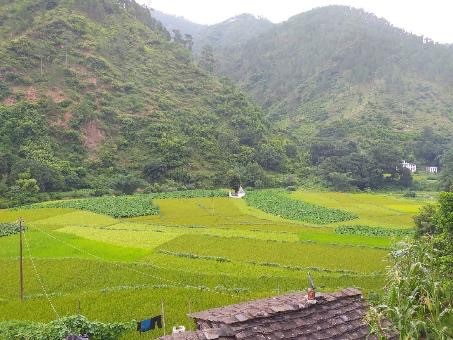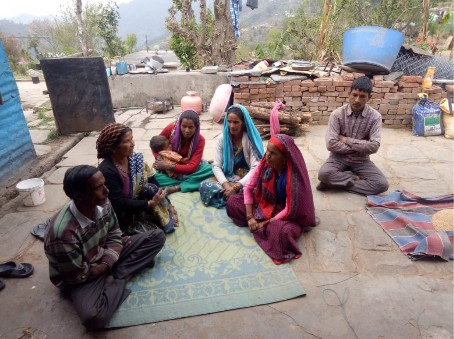Submitted by K.L. Hlaba on Mon, 20/09/2021 - 14:19
Located in the remote Kumaon valley, India, a community radio station called Kumaon Vani reaches out to 300,000 listeners spread across 500 villages in Uttarakhand state. Started by The Energy and Resources Institute (TERI), the radio station raises awareness amongst local people on important issues. This blog focuses on a series of episodes released in early 2021 covering themes of health, nutrition and sustainable agriculture.
Mangalta village, an area planted with diverse traditional crops.
As part of two GCRF funded projects (1), six episodes on the theme of Sustainable Food Systems, titled 'Hamar khet Hamar poshan' (our fields, our nutrition) were broadcast on Kumaon Vani during February and March 2021, encompassing the following topics:
- sustainable and resilient food systems
- nutrition-rich traditional agriculture/non-cultivable produce, biodiversity, ecological farming
- processed junk food and impact on health
- women as farmers
- male participation in household and agriculture-related work and women's workloads
The main purpose of the community radio programme was to raise awareness and build understanding amongst listeners residing in remote areas. The content was designed to encourage people to think critically about different perspectives of formal and informal knowledge systems, in relation to agriculture, health and nutrition, food security and sovereignty, using a gender and social inclusion perspective.
The programme was advertised widely in the area with posters and social media channels, and with teaser trailers on the radio station. People could listen to the episodes live on FM radio or using a YouTube link that was shared on social media. Episodes were broadcast on a weekly basis, and these had three repeat broadcasts in a week at different times of the day to ensure maximum reach, especially to women who spend much time in the fields and forests.
Each episode followed an interview and discussion format and lasted between 10-20 minutes. At least 20 stakeholders were interviewed across the six episodes, including government officials, grassroots health practitioners, functionaries and members of the women’s federation, civil society members, women and men farmers and medical doctors. This diversity ensured a wide range of experiences and worldviews were shared, in both Hindi and the local language, Kumaoni.
Since the pandemic situation prohibited physical meetings, most of the interviews recorded for the episodes, and the small group discussions thereafter, were conducted through mobile communication. This posed significant challenges, particularly as network connectivity was erratic. Many women and some men were uncomfortable sharing their views and experience using mobile technology, therefore interviews had to be recorded in small chunks and often repeated numerous times. Many women could not be contacted initially as their phones had not been charged for many months, with shops closed during lockdowns, so they had to be contacted on their son's, husband's or neighbour's phone.
Impact of the community radio programme
More than 15,000 people across 150 villages tuned in. Feedback was mostly positive, as it reminded people that traditional agricultural and non-cultivated produce used to be part of their daily diet, giving nutritional and medicinal benefits. Listeners were keen to have more episodes on these topics, including how to have a balance between nutritious agricultural crops and modern cash crops, and how to motivate the younger generations to consume and respect local produce.
Women preparing Chyuda, a rice dish with nuts and seeds, distributed amongst neighbours and relatives on Diwali (festival of lights).
To find out how effective the programme was at raising awareness, a small group of people who agreed to listen to all the episodes were asked 10 pre-decided questions, before the programme was broadcast, and again after all the episodes were broadcast. The group comprised women and men of different ages from various districts in rural and urban areas. Their pre-broadcast and post-broadcast responses were documented and compared. Before listening, most were unable to answer more than one question correctly. Except for one woman farmer, no one else knew that women are legally not accepted as farmers. Though they had a good idea of how healthy traditional produce is, none could give any detailed nutritional information about these crops. Most had no idea of the work women’s federations are doing with regards to nutritional supplements, and few had given much thought to men's participation in enhancing nutritional outcomes at the household level.
After listening to the episodes, their responses to the same questions changed. They understood nutritive values in traditional crops like millets, how women farmers federations were engaged in nutrition supplements, the importance of male participation and the need to recognize women as farmers. They acknowledged that the programmes had improved their level of awareness and knowledge on nutrition. Since listening, some have reduced their purchases of processed food such as chips and biscuits and fried foods. Two members decided to consume finger millet at home in the winter season, something they had not done for many years.
A discussion in Tola village about the community radio programme broadcast.
Following the broadcast, easing of lockdown restrictions permitted small groups to meet in open spaces, and some interactive sessions were held with communities in two different areas to listen to some episodes and discuss the themes. The groups listened to the 'women as farmers' and 'male participation in household and agriculture related work and women's workloads' episodes. Before the broadcast, the participants were asked questions and discussion showed that no one had given much thought to the unpaid workload that a woman has and her immense contribution to agriculture. In fact, almost all men (except for one who was unsure) thought women have very limited work and it is the men who do majority of work: "what do they do except cooking and taking care of the household?" argued Mahendra (male, 45 years).
After the broadcast, the men in the discussion groups hesitatingly admitted that women do a lot of work, even during pregnancy and after childbirth. During the sessions, the group analysed their agricultural activities and concluded that women contributed the most. Sumit (male, 33 years) said, "we realise now, in our houses it is the woman who is doing more work, including agriculture and forest related work". The women expressed dismay (as they had not given much thought to it earlier) at the proportion of household and agricultural work they do. One of the women farmers, Govindi (female, 60 years) said, "we never thought we were doing so much work".
The feedback clearly showed women feel access to finance and landownership governance are highly unjust. Women cannot access bank credit, loans or credit cards, as the land is not registered in their name. Kisan samman nidhi (an income support scheme for poorer farmers) is paid to a man's account because he is seen as the landowner. Women expressed sadness that they can only become landowners after the death of their husbands.
The future outlook for sustainable and equitable food systems
Women are now keen to discuss these issues with government officials when they visit the village (in Gram Sabha, village-level governance meetings). Kalawati (female, 60 years), along with other women, expressed an urgent need to raise their voices with government officials "hum mahilaon ko mil kar sarkar se baat karni hogi bhoomi adhikar per, nahi toh un tak hamari baat nahi pahunchegi" (We women will have to talk to the government on land rights, otherwise we will not reach them). They also plan to have discussions at the household level with others in the family.
A repeat broadcast of the radio programme 'Hamar khet Hamar poshan' (our fields, our nutrition) in September coincides with folk plays on the same themes. Two interactive sessions are being conducted with spectators of the folk play by the Kumaon Vani team. These plays and discussions will also be recorded and broadcast. The team looks forward to seeing the impact of these two interesting and effective modes of communication, community radio and folk plays, coming together for awareness and action.
This community radio programme was an effective and economical way to engage with people residing in remote areas. By raising awareness on critical questions relating to their everyday lives, and enhancing understanding of social and gender relations at individual, household and community levels, the programme has contributed to initiating discussions and actions that have the potential to contribute to the future sustainability of local food systems, creating in the process a fertile ground for further livelihood improvements for the people living in the Kumaon valley of India.
An offering (Prasad) to a local deity, made from local pulses, grains, millets and fruits.
This blog was written by Reetu Sogani and Diwan Ram, Lok Chetna Manch, India and Nitya Rao, School of International Development, UEA. It was edited by Hannah Gray, GRTA Project Officer.
Images: supplied by authors.
Note:
(1) TIGR2ESS and GCRF-QR funded projects: Institutional convergence for livelihood and nutrition security and Attaining Food and Nutrition Security through Community Literacy Interventions in Almora district, Uttarakhand, India.




